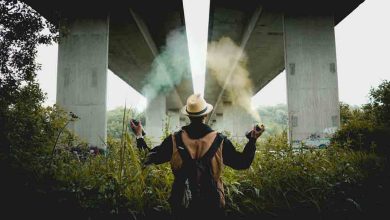Life Style: Joana Hadjithomas: ‘Tapestry restores something deep within you’

HELEN ZUGHAIB
On April 1, US President Joe Biden published an open letter sending the Arab-American community “warmest greetings” in honor of Arab-American Heritage Month. Such a gesture was welcomed by many, including the Lebanese-American artist Zughaib, who emigrated from Lebanon to the US during the civil war. “Finally, you feel proud and hopeful,” Zughaib told Arab News. She was commissioned by cosmetics giant Sephora to create a new artwork for its social media platforms celebrating this special occasion. The result is this joyful, colorful image of dabké dancers and musicians. Zughaib’s work is about finding beauty and hope in stories of personal and collective trauma. “I have a very strong desire to make something palatable that can attract your attention,” she explained.
RANIA MATAR

Lebanese photographer Matar has lived in the US since 1984. Her intimate images explore themes related to adolescence and womanhood, capturing young women laying in the privacy of their bedrooms or immersed in the wilderness. In Matar’s ongoing series “Where Do I Go?” the viewer is confronted with women photographed in abandoned spaces in Beirut, such as this image of a theater lover named Rhea, sitting inside the once-prestigious Piccadilly Theater. “I saw graffiti on the wall that said in Arabic: ‘Where do I go?’ These women are at that crossroads. Where do they go? I was their age when I left Lebanon. Some are leaving; others cannot afford to go anywhere. I want to empower them and tell their story,” Matar wrote in a statement.
SHERIN GUIRGUIS

Los Angeles-based Egyptian artist Guirguis’ artwork is inspired by forgotten stories of marginalized communities, particularly women. This work, “Here Have I Returned,” was a site-specific sculpture created for an exhibition at the Pyramids Plateau in Giza, Egypt last year. It is shaped like a sacred musical instrument played by Hathor, the ancient goddess of music and dance. Embellished with pharaonic-like symbols, the sculpture also pays tribute to the groundbreaking 20th-century Egyptian feminist, Doria Shafik, whose writings are featured. “Serving as both a remembrance of history and an invitation to connect these narratives to the present, the work sets out to make the invisible work of generations of under-recognized women visible once more,” Gurguis said in a statement.
JOHN HALAKA

Egyptian-born Halaka is the son of Palestinian and Lebanese immigrants who made their way to America in 1970. “Until the COVID-pandemic, I’ve traveled to Palestine almost every year to work on various projects,” he told Arab News. In his evocative series, “Ghost of Presence/Bodies of Absence,” Halaka addresses the plight of exiled Palestinian people by placing ink and rubber-stamped text, sometimes appearing in the shape of a human face, on digital photographs of destroyed villages, creating a ghostly effect and mimicking, Halaka said, “the unrelenting tension between the physical absence of Palestinians who have been exiled from their homeland, and the psychological presence of millions of Palestinian refugees who continue the struggle to return to the lands that were stolen from them.”
JACQUELINE REEM SALLOUM

As a first-generation Arab-American, Salloum has devoted much of her time to challenging Arab stereotypes in Hollywood. But recently, the Syrian-Palestinian artist has been experimenting with lively, detailed collages, juxtaposing historical black-and-white pictures with vibrant drawings. “My current work explores more of the connections between personal, collective past, heritage and history through diasporic memory,” she told Arab News. “Remembering the Future,” this mixed-media work, merges the personal story of Sumaya Yousef, a displaced Palestinian woman, and key events that took place in the Sixties, including the 1967 Arab-Israeli War and the 1964-65 World’s Fair — based on the theme of “Peace Through Understanding” — in New York City, Yousef’s future home. Salloum brings out the contradiction and irony of such events: Spectators looking into a utopian bubble of Palestinian refugee girls at school, the voice of Umm Kulthum drowning out the sound of Israeli war planes.
JORDAN NASSAR

Inspired by Palestinian embroidery and working with Arab craftswomen, Nasser, an artist of Palestinian descent born in New York, is known for making patterned, vibrant pieces that reveal imagined landscapes of Palestinian lands. “I would talk to certain Palestinians who had never been there, I noticed they would talk about Palestine in a way that felt really dreamlike — imaginary; a fantasy,” he previously told Arab News. “It was always this perfect, beautiful place with hills, goats and olive trees. I was really moved by this notion that Palestine is this fantasy for so many people in the diaspora.” In this work, “Beyond the Boundaries,” Nassar revisits his reoccurring motif of the rolling hills.
JACKIE MILAD

“I think of my pieces as a record of my decisions over time, a document of my history — my story according to me,” Baltimore-based Milad, who has Egyptian and Honduran origins, told Arab News. Works such as this one, 2021’s “Nada Que Decir” (Nothing to Say), are full of colors, words and symbols. “This work is an accumulation of many layers of collage and marks painted over two years,” she explained. “It includes world news, and quotes from lyrics and poetry. I also mix the languages in the works, reflecting my upbringing.” The title of the work is ironic; the artist expresses a lot of emotion, but has nothing to say in the face of the complexities of identity.
SAMA ALSHAIBI

A woman dressed in a white robe carries a large water vessel over her head, while another woman in black attire carries eight pots stacked vertically. These are two of the powerful shots of Iraqi-born photographer Alshaibi, who said in a statement that she is interested in “the societal impact of unequal power relations between the West and the Middle East, and how that domination is articulated through photographs.” Alshaibi’s “Carry Over” series is a reminder of how Orientalist photographers portrayed women as “exotic” beings. “I aim to amplify the physical burden of their unjust representation by exaggerating the objects (they) carried,” Alshaibi added.
Noting that the news was copied from another site and all rights reserved to the original source.
xnxx,
xvideos,
porn,
porn,
xnxx,
Phim sex,
mp3 download,
sex 4K,
Straka Pga,
gay teen porn,
Hentai haven,
free Hentai,
xnxx,
xvideos,
porn,
porn,
xnxx,
Phim sex,
mp3 download,
sex 4K,
Straka Pga,
gay teen porn,
Hentai haven,
free Hentai,




